There is no day passing by, on which the daily news report about fights, terror
attacks, political disagreements and religious struggles.
The heritage of all these incidents often derive from minor conflicts and
misunderstandings but are able to lead to death, sufferings and wars. This caricature was drawn by a Danish artist and caused a huge intercultural conflict.
The picture was also published in newspaper all over Europe and caused protests in
the Arabic world.
$OWKRXJK WKHQHZVSDSHU³-\OODQGs-3RVWHQ´DSRORJL]HG IRU WKHLQVXOWZRPHQ
protested against the publication and mad students burned Danish flags.
7KLVZDVDW\SLFDO LQWHUFXOWXUDOFRQIOLFWEHFDXVHERWKVLGHVGLGQ¶WNQRZPXFKDERXW
typical traditions, ideologies and habits of each country.
In the Moslem world its not allowed and a death-sin to portray Allah and his prophet
Mohammed.
Although in non-Moslem countries it is ok to do so, most Moslems felt deep insulted
by that action and demanded a punishment for the paper.
Another consequence was several bomb threats by anonymous callers.
This is just one example on how misunderstandings can lead to problems that
involve different parts of the world.
The pope caused another case, where he quoted the emperor Manuel II Palaiologos
saying that the prophet Mohammed just brought bad and inhuman things, by using
the sword to spread his believe.
Once again the Moslem world was upset and protesting, even pope-dolls where burned.
The pope apologized and said that his uttering was misunderstood. This is just one
more incident that caused conflict and harm between cultures and religions.
Only one sentence said wrong in front of a specific audience has the power to cause
protest and struggle.
But conflict could also be considered to be constructive and helping to create a better
state of a relationship. Therefore conflicts are not only inevitable, they really are
healthy and necessary.
Most of the times, the cause of conflicts are just little and almost invisible incidents
during our daily communication with others.
Although these conflicts are inevitable in our everyday life, they easily can escalate
and rise to huge problems.
The main explanation for this, are cultural and ethnic differences in how a situation is
perceived and handled.
This paper is supposed to give a short overview of what a conflict is, which styles of
conflicts there are and how to deal with them as well as a brief summary including
our personal opinions.
Inhaltsverzeichnis (Table of Contents)
- Introduction
- Definitions & explanation of terms concerning conflicts
- Sources of conflicts
- What does a conflict consist of?
- Conflict styles
- How to manage and communicate a conflict
- Managing a conflict successfully
- Communicating a conflict right
- Conclusions
Zielsetzung und Themenschwerpunkte (Objectives and Key Themes)
This paper aims to provide a concise overview of the concept of conflict in intercultural communication. It explores the nature of conflict, its origins, and various conflict styles. The paper also offers insights into effective conflict management and communication strategies, particularly within intercultural contexts.
- The nature and origins of conflict in intercultural communication
- Different styles of conflict and their cultural influences
- Effective strategies for managing and communicating conflict in intercultural settings
- The importance of cultural sensitivity and understanding in conflict resolution
- The potential for conflict to be both destructive and constructive in relationships
Zusammenfassung der Kapitel (Chapter Summaries)
- Introduction: This chapter sets the stage by highlighting the pervasiveness of conflicts in our daily lives, using examples of intercultural conflicts stemming from misunderstandings and cultural differences. It emphasizes the inevitability and even potential benefits of conflict in building stronger relationships.
- Definitions & explanation of terms concerning conflicts: This chapter delves into various definitions of conflict, emphasizing its multifaceted nature and the impact of cultural differences in perceiving and handling conflicts. It introduces the concepts of Individualistic and Collectivistic cultures, highlighting their significance in understanding conflict management.
Schlüsselwörter (Keywords)
This paper explores key concepts such as intercultural communication, conflict management, conflict styles, cultural differences, Individualistic and Collectivistic cultures, and communication strategies. It examines how these concepts intersect and influence conflict dynamics in diverse settings.
- Quote paper
- Judith Zylla-Woellner (Author), 2006, Intercultural Communication: Conflicts - The beginning of destruction or a chance for a better relationship?, Munich, GRIN Verlag, https://www.grin.com/document/210553




